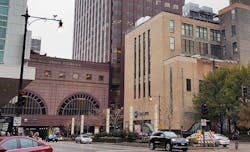CHICAGO – CoreSite is experiencing all aspects of the data center development journey as it builds out its data center infrastructure in downtown Chicago. The colocation specialist has spent the last decade transforming a former Western Union Telegraph building in the heart of the financial district, first upgrading it for use as a 16-megawatt modern data center, and then filling it with tenants.
Now that CoreSite is approaching capacity at its CH1 facility, it is embarking on the next phase of its Chicago strategy: building a purpose-built data center on a two-acre land parcel within a mile of CH1. CoreSite will invest up to $210 million in the CH2 project, which will allow it to continue to meet demand for data center space in downtown Chicago.
“We expect CH2 to enhance our ability to compete effectively in the Chicago market for customer requirements seeking a high performance, cloud-enabled and scalable, higher density colocation solution,” said Paul Szurek, Chief Executive Officer at CoreSite.
Chicago is one of the nation’s premier markets for data center services, occupying a central place in America’s geography and mission-critical infrastructure. While many data center developers have expanded in the western suburbs of surrounding O’Hare Airport, CoreSite has focused on serving the market in Downtown Chicago, which is home to major trading exchanges for stocks, commodities and options, making the city a hotbed of activity for the financial services industry.
The CoreSite CH2 project continues a burgeoining data center renaissance in the Downtown Chicago market, where most of the data center activity has historically been focused on a handful of buildings. The focal point has long been 350 East Cermak, the huge carrier hotel and interconnection hub operated by Digital Realty.
Four-Story Greenfield Build
CoreSite acquired two acres of land at 550 W. 14th Place for $4.5 million, according to local media. It plans to build a 175,000-square-foot, four-story data center supporting 18 critical megawatts of power capacity.
“CH2 is one mile from our existing CH1 facility and network node and we plan to connect the two sites via diverse, high-count dark fiber to create the type of campus interconnectivity most valued by our scale customers,” said Szurek.
CoreSite expects to start construction on CH2 at the end of 2018 or the beginning of 2019, with timing dependent upon the receipt of necessary entitlements and permits. It expects to construct the building in three phases, each with 6 megawatts of capacity.
The new project utilizes one of CoreSite’s historic strengths – building vertical data centers in urban areas. The company got its start as largest colocation provider at One Wilshire, the iconic 30-story telecom hub in downtown Los Angeles. In Virginia the company’s VA2 is a greenfield build with a five-story design, with the top floor housing mechanical and electrical infrastructure, and the remaining four floors dedicated to data halls for tenants. In 2016 CoreSite completed SV7, a four-story facility that is the tallest data center in Santa Clara.
In CoreSite’s recent earnings call, Szurek said the company’s strategy for urban expansion in Los Angeles provides a good blueprint for its Chicago strategy. The company’s LA2 “Wilshire Annex” is about a mile from One Wilshire (LA1), with fiber between the buildings.
“LA1 and LA2 are a great example of the tremendous synergies you can achieve by providing enterprise class, scalable, more power efficient new space that that has this type of dark fiber connectivity back to your main network node,” said Szurek. “It really expands the use cases and the edge cases that can take place in the urban core where there is a much more enterprise rich target environment. And it’s essentially our model, and we were very, very focused on finding this type of opportunity in downtown Chicago.
“We’ve had ongoing conversations with customers aboutwhat they need and where they need it,” he said. “This is exactly the type of product needed in Chicago.”
Power Upgrade in the Financial District
CoreSite CH1 is in the heart of the financial district, immediately next to the Chicago Stock Exchange and Chicago Board of Trade. Our first visit to 427 S. LaSalle was in early 2009, less than a year after CoreSite (then known as CRG West) had acquired the property. At the time, the seven-story building had several floors of data center space, a collection of carriers, and a number of remaining office tenants. In an initial round of upgrades, CoreSite had built out two 20,000 square foot data halls in retrofitted space within the building.
Over the next several years, CoreSite undertook an extensive upgrade of the power infrastructure, working with local utility ComEd to expand the building’s electrical capacity by 10 megawatts (MWs), to a total of 16 MWs. The project required an overhaul of systems from the bottom to the top of the building. Two sets of switchgear were installed in the basement, each enclosed in concrete vaults. Meanwhile, CoreSite added four new Cummins 2 MW emergency backup generators, hoisting the gensets onto the roof, where they are stacked two high. The company also isntalled 510 tons of “smart chillers” in another rooftop enclosure to expand the building’s cooling capacity.
One of the new chiller systems in a rooftop enclosure at the CoreSite CH1 data center in Chicago. (Photo: Rich Miller)
Once the power and cooling infrastructures were in place, CoreSite transformed the entire building into data center space, replacing office tenants as their leases expired and retrofitting the space as data halls. CoreSite built out three risers within the building framework to support an equipment elevator and power and cabling runs.
CoreSite has about 1 megawatt of space available at 427 S. LaSalle, spread across data halls on several floors of the building.
New Activity in Downtown Chicago
Downtown Chicago has primarily been a retail colocation market, offering connectivity and interconnection services but few large physical footprints. Space at 350 Cermak and other downtown hubs has been in short supply in recent years, with limited new inventory coming online. That’s beginning to change, with several new data center developments underway or on the drawing board.
Last year QTS Realty Trust, Inc. (QTS) opened a data center in the former Chicago Sun-Times printing plant on South Ashland Avenue. QTS offers up to 6 megawatts of space in the first phase of its project, with a potential buildout of 24 megawatts.
Digital Realty has announced plans for an expansion in Downtown Chicago. Digital’s 330 East Cermak will be a 12-story data center, allowing low latency connections to the critical mass of networks providers housed next door at 350 East Cermak. The site is “shovel-ready” and will break ground as soon as it signs an anchor tenant for the project, which aligns with Digital Realty’s connected campus strategy of bringing together real estate and network services by creating data centers adjacent to Internet on-ramps.
Just down the street, James McHugh Construction has announced plans for a project known as Cermak Square Data Center, which is envisioned as a seven-floor purpose-built data center project in a 363,000 square foot greenfield building. The builders say the project can support 16 MWs of capacity initially, with expansion capability for up to 40 MWs.
Meanwhile, Ascent is building a new facility on South Desplaines, and 1547 Realty is seeking to purchase the Schulze Banking Company building on the Chicago’s South Side and plans to convert it for mission-critical space






